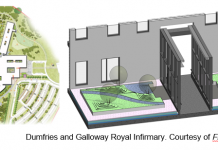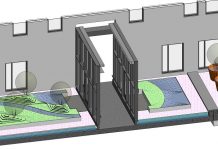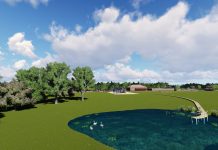Martyn Horne of the Landscape Institute’s BIM Working Group highlights how landscape architects can collaborate and share information with their project teams in the evolving process of BIM
Any person or company setting out on the BIM journey may understandably think that BIM and its associated term, the Building Information Model, refers directly to buildings or more specifically, architecture. They may also be forgiven for thinking that it also refers to a particular file format or specific piece of software. However, BIM is not a file format, it is not a piece of software and it is not even an information technology. Rather it is a business process that is defined by a series of workflows (that may vary from project to project) and these workflows are enabled by information technology. Furthermore, the building referred to in its name is not a noun as in ‘the building’, but a verb, as in ‘to build’. This is the first step to understanding how landscape architecture fits into the BIM.
Collaboration and communication
A key aim of the BIM process is to facilitate collaboration, communication and the effective exchange of data between different members of the construction team.
A typical visual definition of BIM is heavily focused on the architecture and it’s often shown without even a basic terrain. But a building cannot, and does not exist as a separate entity to its site. Even at a basic planning level stage, the 3D model and its linked 2D plans, elevations, sections and information schedules communicate so much more information because they involve the site.
At the Landscape Institute we recognise the need to collaborate in order to get schemes built. The Building Information Model itself, can be seen as a manifestation of that collaborative process of communication and information exchange. It is most easily understood by a three dimensional digital model of the project to be constructed.
From this model it is possible for the various parties involved in the project to extract both visual and data-based information back out of the model. For example, plans, elevation and sections can be taken or cut through the model and information can be generated in the form of reports and schedules.
Crucially, because the information can be taken from the live model, a great deal of the repetitive work encountered in traditional 2D CAD based drawing and schedule creation can be reduced and just as importantly, errors can be reduced or eliminated.
What can landscape BIM offer specifically?
In addition to the traditional documentation stage, the landscape BIM can offer terrain water flow analysis, minimum and maximum grading analysis, site cut and fill calculations, water volumes, existing tree survey and tree protection planning, planting schedules, material quantities, maintenance reports and clash avoidance with underground services.
Both the Landscape Institute and the UK Government recognise that the software required to design and document architecture and engineering is not necessarily going to be the best software for landscape architects. It is one of the reasons that both institutions support the move to certified, but neutral file formats such as IFC and data exchange standards such as COBie and Product Data Templates.
Helping the industry change
One of the remits of the Landscape Institute’s BIM Working Group, which was set up approximately two years ago, is to develop change within the industry.
To highlight a couple of the group’s recent activities, we are currently running a series of BIM Masterclasses around the country to present the BIM workflow within the context of the UK Government’s Mandate for BIM Level 2, and the Digital Plan of Work within landscape architecture. The group is also involved in developing a series of Landscape Industries Product Data Templates which will feed directly into BIM Level 2 COBie datasets.
Conclusion
Change can be disruptive. Without a doubt, BIM will require an understanding of new processes and possibly the acquisition of new skills. But it is also important that as a design profession, we also maintain the values that make us unique. Too often, conversations about BIM exclude reference to quality of design, creativity and visual communication and it is really important that as we explore digital approaches and embrace the efficiencies of the new, that we also maintain the best of our traditional techniques and skills and expertise at the same time. It is an interesting time for landscape architecture as it is for the entire construction industry, but there has probably never been a time when the holistic perspective of the landscape architect has been more valuable.
For more information, please visit the BIM section of the LI website at:
http://www.landscapeinstitute.org/knowledge/BIMOpenProject.php.
Martyn Horne
Landscape Institute
Tel: +44 (0)207 685 2640










